UK: Syrian Bee Hawkmoth
Haemorrhagia fuciformis syra Daniel, 1939, Mitt. münch. ent. Ges. 29: 94.Type locality: Marasch, Turkish north Syria [Kahraman Maras, Turkey].
(Taxonomic notes. (i) The descriptions and illustrations provided by Daniel (1932; 1939) of the Turkish Hemaris fuciformis subsp. syra Daniel, 1939, initially indicated that it could be a form of Hemaris dentata (Staudinger, 1887). However, Daniel (1932) was of the opinion that it was closer to Hemaris fuciformis (Linnaeus, 1758), although the colour of the thorax and abdomen reminded him more of Hemaris croatica (Esper, 1800). Danner, Eitschberger & Surholt (1998) treated Hemaris syra as a good species, although they were uncertain of its exact status. Kitching & Cadiou (2000) compared Hemaris syra, Hemaris fuciformis and Hemaris dentata (Staudinger, 1887) from Turkey and concluded that Hemaris syra probably represented the opposite sex of the sexually dimorphic Hemaris dentata. With the capture of further specimens of both Hemaris syra and Hemaris dentata it has become clear that Hemaris syra is not conspecific with Hemaris dentata, but in morphology closer to Hemaris fuciformis. Furthermore, the results of recent DNA barcoding studies has confirmed that although this taxon is close to Hemaris fuciformis and Hemaris dentata, it is sufficiently distinct to warrent specific status.
(ii) Externally only reliably distinguishable from Hemaris fuciformis by the male genitalia, which are similar. However, in H. dentata the right harpe is reduced to a short, blunt, barely differentiated lobe.
(iii) The description and illustration of Hemaris fuciformis pseudodentata given by Dubatolov (2003) matches the holotype of Hemaris syra. Although he compared his new taxon with Hemaris dentata and Hemaris fuciformis fuciformis, he did not include Hemaris syra in the comparison. The former is synonymized with the latter.)
Holarctic; western Palaearctic region. Pleistocene refuge: Monocentric -- Caspian refugium, with probably a small population extending to the northern Iranian refuge.
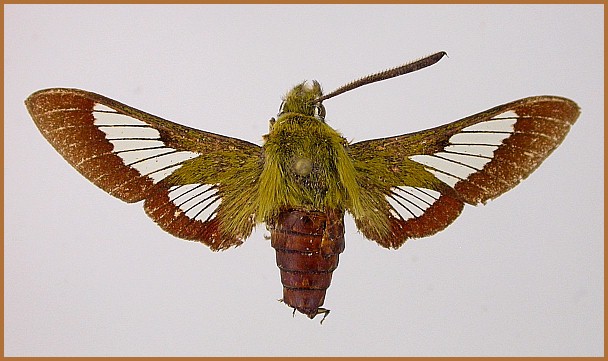
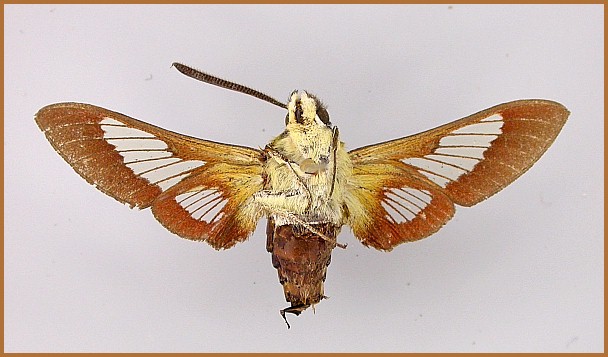
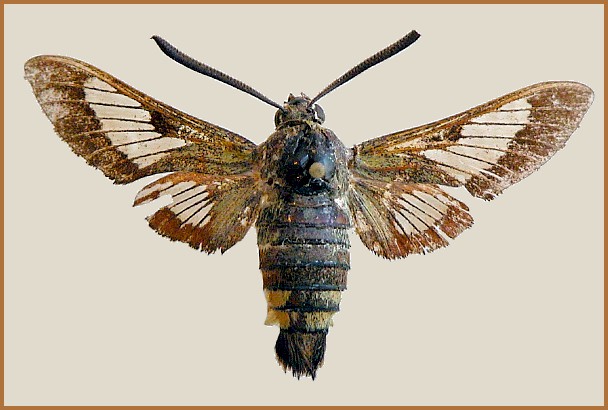
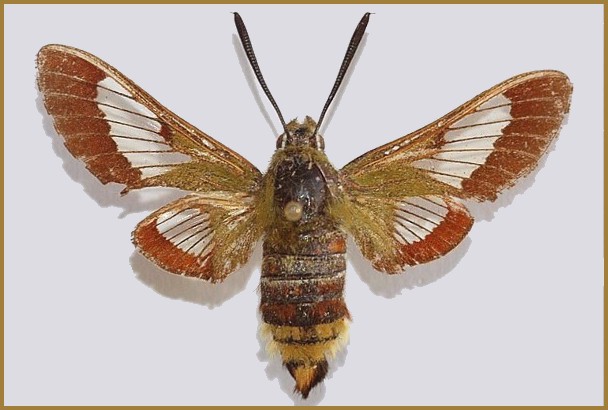
Wingspan: 35--48mm. Distinguished from Hemaris tityus (Linnaeus, 1758) by a much broader marginal band to the wings; forewing discal cell divided longitudinally by a scaled fold in most examples, but this is obscured in Hemaris syra by the discal cell being totally covered by scales. This feature, plus a reduced hyaline area on the hindwings, distinguish this species from Hemaris fuciformis fuciformis; however, individuals of Hemaris fuciformis fuciformis matching Hemaris syra can occasionally be found in Greece and Italy, particularly in the second brood.
Care should be taken when identifying live individuals of this species in the field in southern Turkey. Several photos of it have appeared on the internet in recent years labelled Hemaris croatica. To confuse matters further, many individuals also resemble Hemaris dentata (Staudinger, 1887).
Diurnal. Frequents the open remnants of former woodland, especially damper areas where Lonicera grows under, inbetween, through and over low shrubs. Occurs at around 850-1400m altitude in southern Turkey, 1500-1600m in northern Israel, 1400m in Azerbaijan and 1850-2500m in Iran. Adults are partial to the flowers of thistles.
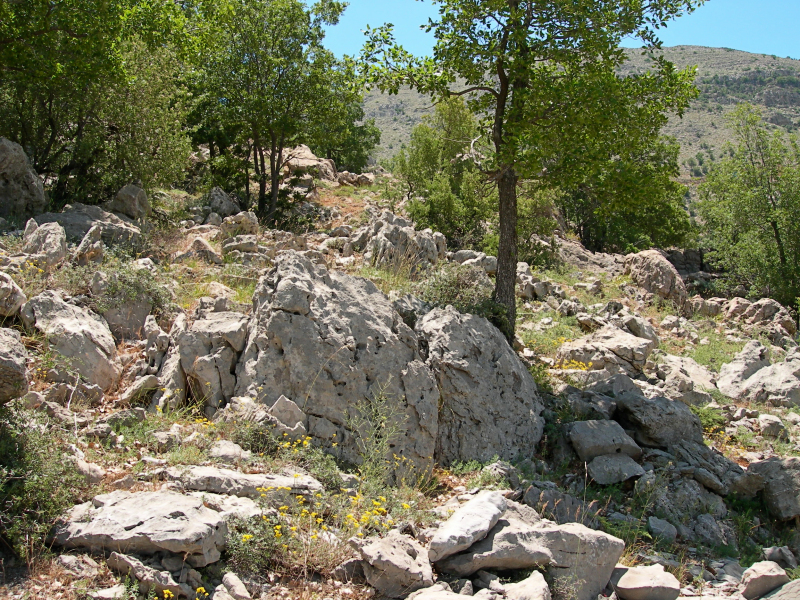
Bivoltine throughout its range. Mainly from mid May until mid June, with a partial to full brood in August. Two specimens were observed in Jordan (Mafraq, 700m) in mid July (Müller et al., 2005a).
OVUM: Unknown.
LARVA: Unknown.
Hostplants. Unkown, but probably species of Lonicera or Cephalaria.
PUPA: Unknown.
None recorded.
Southern and southeastern Turkey (Yahyali, near Kayseri; Tortum, near Erzurum; 8km south of Baykan, near Siirt; Zaptal, near Hakkari) (Daniel, 1932; Daniel, 1939; Kemal & Koçak, 2018; Koçak & Kemal, 2018), northeastern Turkey (Posof, Ardahan Province) (Kemal, Kızıldağ & Koçak, 2018), northern Iraq (Sarsank/Sersink, near Amedi) (Kemal & Koçak, 2018c), the western Zagros Mountains of Iran (Dasht-e-Arjan/Arzhan village, west of Shiraz; Saravand, near Dorud, Lorestan), the northern Alborz Mountains of Iran (15km east of Firuzkuh; Vali-Abad, near Mazandaran; Veresk village, north of Tehran; Shah Reza National Park, near Gorgan), the southeastern corner of Azerbaijan (Talysh, near Astara (Snegovaya & Petrov, 2021)), and the Kopet-Dagh Mountains of Turkmenistan (Danov & Pereladov, 1985; Derzhavets, 1984; Dubatolov, [1999]).
Also recorded from western Jordan (Mafraq (Müller et al., 2005a)) and northern Israel (as Hemaris syriaca) (Müller et al., 2005b; Pittaway, pers. obs.; Yael Orgad, iNaturalist 2020).
[It is possible that most, if not all, populations of Hemaris fuciformis fuciformis reported from southern and central Turkey (Daniel, 1932; Daniel, 1939; Koçak & Kemal, 2018) are, in fact, Hemaris syra, and that Hemaris fuciformis fuciformis is rare in Turkey and confined to the northern Pontic Mountains fringing the Black Sea -- there is one confirmed record from Ayancik near Sinop. Individuals of Hemaris fuciformis fuciformis have also been confirmed from the Alborz Mountains of northern Iran (Lehmann & Zahiri, 2011) and from Azerbaijan (Snegovaya & Petrov, 2021).]
Extra-limital range. None.
None.
 Return to species list
Return to species list